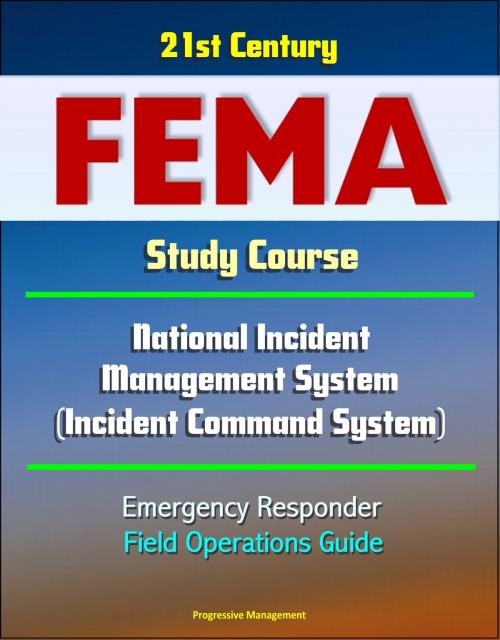21st Century FEMA Study Course: National Incident Management System (Incident Command System) Emergency Responder Field Operations Guide
Nonfiction, Social & Cultural Studies, Social Science| Author: | Progressive Management | ISBN: | 9781310013744 |
| Publisher: | Progressive Management | Publication: | September 11, 2014 |
| Imprint: | Smashwords Edition | Language: | English |
| Author: | Progressive Management |
| ISBN: | 9781310013744 |
| Publisher: | Progressive Management |
| Publication: | September 11, 2014 |
| Imprint: | Smashwords Edition |
| Language: | English |
This Field Operations Guide contains voluntary guidance and is designed to assist emergency response personnel in the use of the NIMS Incident Command System (ICS) during incident operations. This guide is intended for use when implementing ICS in response to an incident, regardless of type, size, or location. It does not replace emergency operations plans, laws, regulations, and ordinances. Rather, this document provides guidance for assigned incident personnel. This document follows the guidelines set out by NIMS for the use of plain language and clear text; therefore, the document contains few acronyms.
CHAPTER 1 - INTRODUCTION * CHAPTER 2 - INCIDENT COMMAND SYSTEM (ICS) OVERVIEW * ICS Overview * Modular Extension * Operations Section * Planning Section * Logistics Section * Finance/Administration Section * ICS Organization Chart * CHAPTER 3 - COMMON RESPONSIBILITIES * Accountability Procedures * Common Responsibilities * Leadership Responsibilities * CHAPTER 4 - OPERATIONAL PLANNING CYCLE * Operational Planning Cycle * Planning "P" CHAPTER 5 - COMMAND STAFF * Organization Chart * Position Checklists * CHAPTER 6 - UNIFIED COMMAND * Introduction * UC Composition * CHAPTER 7 - OPERATIONS SECTION * Organization Chart * Position Checklists * CHAPTER 8 - PLANNING SECTION * Organization Chart * Position Checklists * CHAPTER 9 - LOGISTICS SECTION * Organization Chart * Position Checklists * CHAPTER 10 - FINANCE/ADMINISTRATION SECTION * Organization Chart * Position Checklists
The National Incident Management System (NIMS) provides a consistent nationwide template to enable Federal, State, tribal, and local governments, nongovernmental organizations (NGOs), and the private sector to work together to prevent, protect against, respond to, recover from, and mitigate the effects of incidents, regardless of cause, size, location, or complexity. NIMS represents a core set of doctrines, concepts, principles, terminology, and organizational processes that enables effective, efficient, and collaborative incident management. This consistency provides the foundation for utilization of NIMS for all incidents, ranging from daily occurrences to incidents requiring a coordinated Federal response. Homeland Security Presidential Directive 5 (HSPD-5), Management of Domestic Incidents, directed the development and administration of NIMS.
The NIMS documents integrate best practices into a comprehensive framework for use by emergency management and response personnel in an all-hazards context nationwide. HSPD-5 requires all Federal departments and agencies to adopt NIMS and to use it in their individual incident management programs and activities, as well as in support of all actions taken to assist State, local, and tribal governments. State, local, and tribal governments are not required to participate in NIMS or adopt these best practices. As applied to non-Federal entities, NIMS documents contain guidance that is not legally binding. However, in order to participate in NIMS and to be considered NIMS compliant, it is necessary for entities to adhere to the standards, practices, and/or minimum criteria presented in the NIMS guidance documents. It is also important to note that although a State, local, or tribal government or NGO is not required to apply for Federal preparedness assistance, HSPD-5 requires Federal departments and agencies to make adoption of NIMS by State, local, and tribal governments and NGOs a condition for Federal preparedness assistance through grants, contracts, and other activities.
This Field Operations Guide contains voluntary guidance and is designed to assist emergency response personnel in the use of the NIMS Incident Command System (ICS) during incident operations. This guide is intended for use when implementing ICS in response to an incident, regardless of type, size, or location. It does not replace emergency operations plans, laws, regulations, and ordinances. Rather, this document provides guidance for assigned incident personnel. This document follows the guidelines set out by NIMS for the use of plain language and clear text; therefore, the document contains few acronyms.
CHAPTER 1 - INTRODUCTION * CHAPTER 2 - INCIDENT COMMAND SYSTEM (ICS) OVERVIEW * ICS Overview * Modular Extension * Operations Section * Planning Section * Logistics Section * Finance/Administration Section * ICS Organization Chart * CHAPTER 3 - COMMON RESPONSIBILITIES * Accountability Procedures * Common Responsibilities * Leadership Responsibilities * CHAPTER 4 - OPERATIONAL PLANNING CYCLE * Operational Planning Cycle * Planning "P" CHAPTER 5 - COMMAND STAFF * Organization Chart * Position Checklists * CHAPTER 6 - UNIFIED COMMAND * Introduction * UC Composition * CHAPTER 7 - OPERATIONS SECTION * Organization Chart * Position Checklists * CHAPTER 8 - PLANNING SECTION * Organization Chart * Position Checklists * CHAPTER 9 - LOGISTICS SECTION * Organization Chart * Position Checklists * CHAPTER 10 - FINANCE/ADMINISTRATION SECTION * Organization Chart * Position Checklists
The National Incident Management System (NIMS) provides a consistent nationwide template to enable Federal, State, tribal, and local governments, nongovernmental organizations (NGOs), and the private sector to work together to prevent, protect against, respond to, recover from, and mitigate the effects of incidents, regardless of cause, size, location, or complexity. NIMS represents a core set of doctrines, concepts, principles, terminology, and organizational processes that enables effective, efficient, and collaborative incident management. This consistency provides the foundation for utilization of NIMS for all incidents, ranging from daily occurrences to incidents requiring a coordinated Federal response. Homeland Security Presidential Directive 5 (HSPD-5), Management of Domestic Incidents, directed the development and administration of NIMS.
The NIMS documents integrate best practices into a comprehensive framework for use by emergency management and response personnel in an all-hazards context nationwide. HSPD-5 requires all Federal departments and agencies to adopt NIMS and to use it in their individual incident management programs and activities, as well as in support of all actions taken to assist State, local, and tribal governments. State, local, and tribal governments are not required to participate in NIMS or adopt these best practices. As applied to non-Federal entities, NIMS documents contain guidance that is not legally binding. However, in order to participate in NIMS and to be considered NIMS compliant, it is necessary for entities to adhere to the standards, practices, and/or minimum criteria presented in the NIMS guidance documents. It is also important to note that although a State, local, or tribal government or NGO is not required to apply for Federal preparedness assistance, HSPD-5 requires Federal departments and agencies to make adoption of NIMS by State, local, and tribal governments and NGOs a condition for Federal preparedness assistance through grants, contracts, and other activities.















